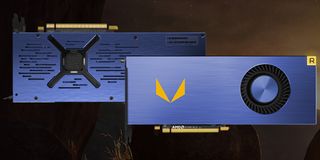Early benchmarks show Vega Frontier Edition beating Titan Xp
Things are looking good for AMD's upcoming GPU.

When the time comes, we will be looking at in-depth performance comparisons between AMD's upcoming Radeon RX Vega and existing Pascal cards. In the meantime, AMD has been eager to showcase its next-generation GPU architecture in limited demonstrations to give us a taste of what's in store. To keep the hype train rolling, AMD officials provided PCWorld with a hands-on preview of one of the first Radeon RX Vega Frontier Edition productions cards.
We'll jump into the numbers in just a moment, but first a quick refresher on the Frontier Edition. AMD unveiled the Frontier Edition during its Financial Analyst Day presentation last month. It's a muscular variant of Vega intended for professionals. The card wields 64 compute units, which works out to 4,096 stream processors, the same as AMD's Radeon Fury X. It also has 16GB of HBM2 memory on a wide 2,048-bit bus, clocked at around 1,875MHz (480GB/s).
AMD claims 25 teraflops (TFLOPS) of half-precision FP16 compute performance and 13 TFLOPS of single-precision FP32 compute performance, both of which are peak metrics. On paper, that puts Vega ahead of Nvidia's Titan Xp, which offers 12 TFLOPS of FP32 compute power.
For the hands-on demonstration that AMD gave to PCWorld, the company configured two identical PCs (save for the graphics card) outfitted with a Ryzen 7 1800X processor, 32GB of DDR4-2400 RAM, and SSDs for storage, all connected to multiple 4K panels. Even the mouse and keyboard were the same on both setups. One of the systems was equipped with a Frontier Edition card and the other had a Titan Xp. So, how did things shake out?
"In the given time we had to run the tests, we saw the Frontier Edition outscore the Titan Xp by 28 percent in Catia and Creo to 50 percent in SolidWorks. We also ran Maxon’s Cinebench, a popular OpenGL benchmark, in which the Frontier Edition was about 14 percent faster," PCWorld noted.
While impressive, it's worth mentioning that AMD is pitting a professional graphics card against the competition's top-end consumer card. The benchmarks are professional applications as well, and SpecViewPerf traditionally runs much faster on Nvidia's Quadro cards.
That doesn't make the comparison totally bogus. While Nvidia's professional Quadro cards would perform better in these tests than the Titan Xp, the professional equivalent to the Titan Xp is the Quadro P6000, which sells for nearly $6,000. AMD's Frontier Edition is much less expensive—the air-cooled model will sell for $1,200, while a liquid-cooled variant will go for around $1,800.
The biggest gaming news, reviews and hardware deals
Keep up to date with the most important stories and the best deals, as picked by the PC Gamer team.
As to gaming performance, AMD isn't sharing too much at the moment. It did previously say that the Radeon RX Vega for consumers will be faster than the Frontier Edition for gaming, but beyond that, AMD is keeping mostly mum. That was again the case for this latest demonstration. PCWorld was allowed to play Doom using Vulkan, Prey using DirectX 11, and Sniper Elite 4 using DirectX 12 on both cards with the games set to their highest settings. For what it's worth, PCWorld wasn't able to tell a difference when switching between the Frontier Edition and Titan Xp.
The takeaway here is that Vega is looking good so far, both in professional chores and gaming. To extrapolate much more, however, would be premature at this point. We need to know power requirements, price, and real-world gaming benchmarks. RX Vega is set to launch in late July.
Paul has been playing PC games and raking his knuckles on computer hardware since the Commodore 64. He does not have any tattoos, but thinks it would be cool to get one that reads LOAD"*",8,1. In his off time, he rides motorcycles and wrestles alligators (only one of those is true).
Most Popular






